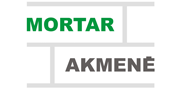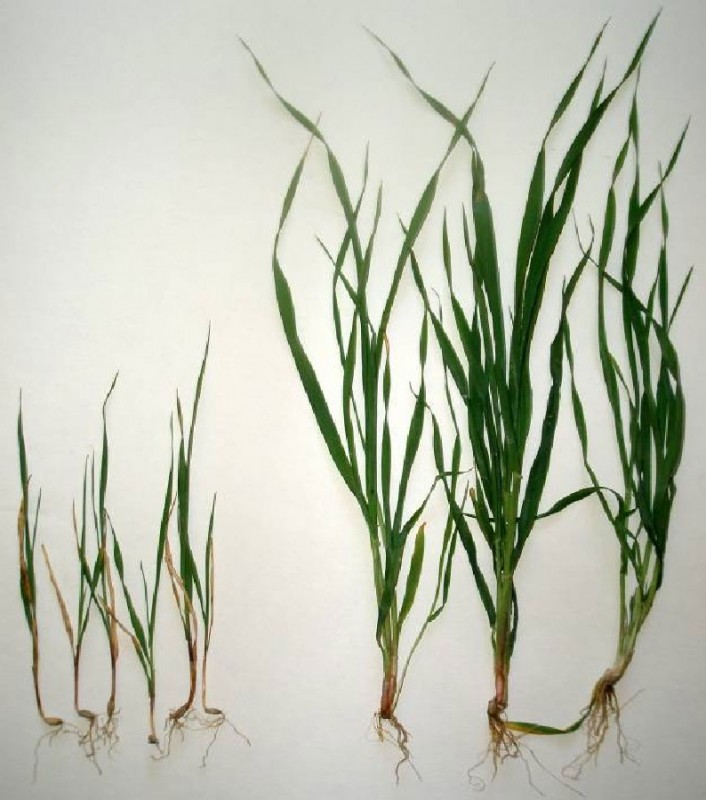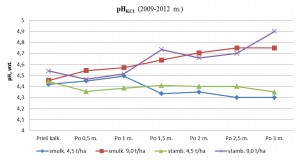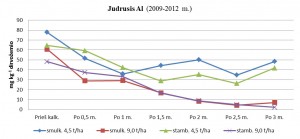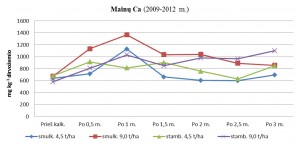![]() Why do we need liming?
Why do we need liming?
Soil acidification is one of the forms of its chemical degradation associated with growing number of aluminium and hydrogen ion concentration in the soil solution. This process is continuously going on in the Lithuanian soil.
Relatively acidic soils (pH ≤ 5.5 ) in the Western part of Lithuania take about 31.3 %, in the Middle Lithuania about 6.7 %, and in the Eastern Lithuania about 11 %. Acid soil areas in different regions of Lithuania are predetermined by native rock on which these soils (dystric albeluvisol and luvisol) formed. The above soils sorption complex is dominated by large amounts of hydrogen, they are rich of mobile aluminium and manganese, iron, copper and zinc. Especially toxic for the plants is mobile aluminium. In the soil solutions, depending on the pH of the solution, aluminium may take different ionic forms. Of these, the most reactive and available and the worst for the plants in acidic solutions is its trivalent form (Al+3). Trivalent aluminium compounds (especially Al(OH)3) inhibits growth of roots and young sprouts most strongly. Plant roots become short, thickened and twisted, plant seedling tops turn brown and die. The toxic effect of aluminium occurs in the very acidic soil, when its contents reaches 50-100 mg/kg or more. Main liming must be carried out in the soil containing these characteristics.
|
|
In highly acidic soils, many agricultural crops (wheat, barley, clover, corn, rapeseed, alfalfa, sugar beets) fail and die in the early stages of growth. | |
|
Not limed |
Limed | |
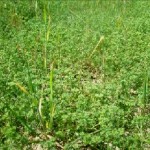
Not limed |
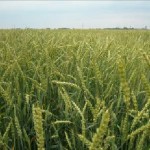
Limed |
Winter wheat is especially sensitive to acid soil reaction.
In the acidic soil its crop is very rare, predominant by weeds, the plants are scarce while after liming their culture is of optimal density and weed-free.
|
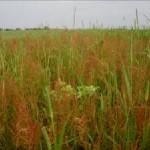
Not limed |
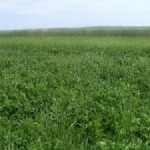
Limed |
Red clover in acid reaction soil disappears, small sorrel starts prevailing instead, but after liming clover produces large (8-9 t/ha) yield. |
Mobile aluminium becomes harmful to plants at levels higher than 10 mg/kg of soil, and growth significantly slows at the level of 30-50 mg/kg.
Soil acidity is the agrochemical property meaning soil acidity, neutrality or alkalinity. Lithuania’s soils according to the exchange potential acidity are divided as follows:
1) extremely acidic – pHKCl<3.5,
2) very acidic – pHKCl3.6 – 4.5,
3) moderate acidity – pHKCl 4.6 – 5.0,
4) low acidity – pHKCl 5.1-5.5,
5) slightly acidic – pHKCl 5.6-6.0
6) neutral-like – pHKCl 6.1-6.5
7) close to neutral acidity – pHKCl 6.6-6.9,
8) with neutral pH and alkaline – pHKCl 7.0-8.5,
9) alkaline – pHKCl > 8.5.
Soils with pHKCl 5.5 and less are relatively acidic and need emergent liming. To maintain pHKCl at such and higher rate it is essential to maintain liming in soil plough layer, which is also important due to climate changes. Under effect of above conditions effective is maintenance liming in combination with organic matter depositing. Recently, due to the increased atmospheric pollution with sulphur and nitrogen compounds, the contaminated acid rains promote hydrogen and Al+3 ions number growth in the soil, frequent rain precipitation in the cold season and torrential rainstorms during the warm period stimulate leaching of alkali cations (Ca+2 and Mg+2) and organic carbon. This is confirmed by current chemical status of no longer limed soils becoming acidic: amount of exchangeable cations decreases and amount of toxic aluminium increases. Scientists identify these processes as secondary acidification of limed soil, which is stopped by annual supportive liming. All this shows that the soil acidification process tends to strengthen and its impeding measures are as never before necessary not only in the respect of production yield, but also in the soil as a natural resource preservation sense.
Research of Lithuanian Agriculture and Forestry Sciences Center Vėžaičiai branch evaluated:
Efficiency of main liming with granulated substances Kalktrąšė on soil and crop yield under the scheme:
1. Unlimed
2. Limed according to soil’s hydrolytic acidity with different size granular Kalktrąšė:
• 0,5 rate (4,5 t/ha), Ø 0,01 – 2 mm
• 1,0 rate (9,0 t/ha), Ø 0,01 – 2 mm
• 0,5 rate (4,5 t/ha), Ø 2 – 5 mm
• 1,0 rate (4,5 t/ha), Ø 2 – 5 mm
Precision field trials were set on average cultivated soil being Dystric Albeluvisol. Soil plough layer was 20 to 28 cm thick, silty clumpy, light and medium loam with pHKCl 4.5 (slightly acid soil). In the soil of such reaction main liming was carried out, which was to neutralize soil acidity and to improve nutrient availability to plants.
Efficiency of supportive liming with granulated substances Kalktrąšė with humus on soil and crop yield under the scheme:
1. Unlimed
2. Limed with 0.5 t/ha and 1.0t/ ha Kalktrąšė with humus (0.5 %).
Precision field trials were set on average cultivated soil being Dystric Albeluvisol. Soil plough layer 20 to 28 cm thick, silty clumpy, light and medium loam with pHKCl 5.1 to 5.3 (low acid soil). In the soil of such reaction supportive liming was carried out, which was to maintain and increase the existing soil pH and to create optimal conditions for plant growth.
Kalktrąšė was scattered and inserted to 7-11 cm depth.
The research results:
Main liming.
Chemistry changes of the naturally acidic soil prevalent in the Western Lithuania depended on the amount of granulated lime substance and granular fraction coarseness:
For the main liming Kalktrąšė rate 0.5 (4.5 t/ha) was too small, because three years after liming the soil remained acidic with pHKCl 4.4, with a lot of toxic for the plants mobile Al: 41.8 to 48.3 mg/kg and a little exchange Ca 697-850 mg/kg.
|
Options |
Yield of red clover dry substance , t/ha | ||
|
1st harvest |
2nd harvest |
Annual |
|
| 1. Unlimed | 2,44 | 1,08 | 3,52 |
| 2. Kalktrąšė 0,5 rate (4,5 t/ha) fine fraction | 6,06** | 3,63** | 9,69** |
| 3. Kalktrąšė 1,0 rate (9,0 t/ha) fine fraction | 5,73** | 4,14** | 9,87** |
| 4. Kalktrąšė 0,5 rate (4,5 t/ha) coarse fraction | 5,24** | 3,47** | 8,71** |
| 5. Kalktrąšė 1,0 rate (9,0 t/ha) coarse fraction | 6,08** | 3,51** | 9,59** |
|
R05 |
1,262 | 0,394 | 0,902 |
Note : ** is statistically significant at the 99 % probability level.
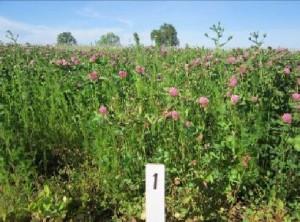 |
Unlimed soil (clover dominated by weeds) 2012
|
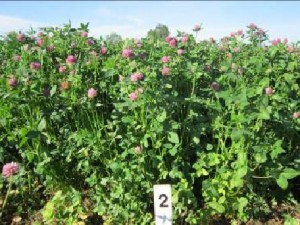 |
Red clover in limed soil (0.5 rate of Kalktrąšė Ø 0.1 to 2.0 mm) 2012
|
|
|
Maintenance liming.
To improve chemical and microbiological properties and rise plant productivity in the Western Lithuania’s low acidity soil Kalktrąšė with humus, as an effective liming material, is used every year (0.5 or 1.0 t/ha) with other mineral fertilizers.
| Options | Grain yield | Extra grain t/ha, compared with the reference group
|
|
|
| t ha-1 | % | |||
| 1. Unlimed (reference) 4,11 100 | 4,11 | 100 | — | |
| 2. Limed 0,5 t ha-1 (Kalktrąšė 95,5 % + hum. 0,5 %) 4,28 104 + 0,17 | 4,28 | 104 | + 0,17 | |
| 3. Limed 1,0 t ha-1 (Kalktrąšė 95,5 % + hum. 0,5 %) 4,67** 103 + 0,56 | 4,67** | 103 | + 0,56 | |
| R05 | 0,261 | — | — | |
